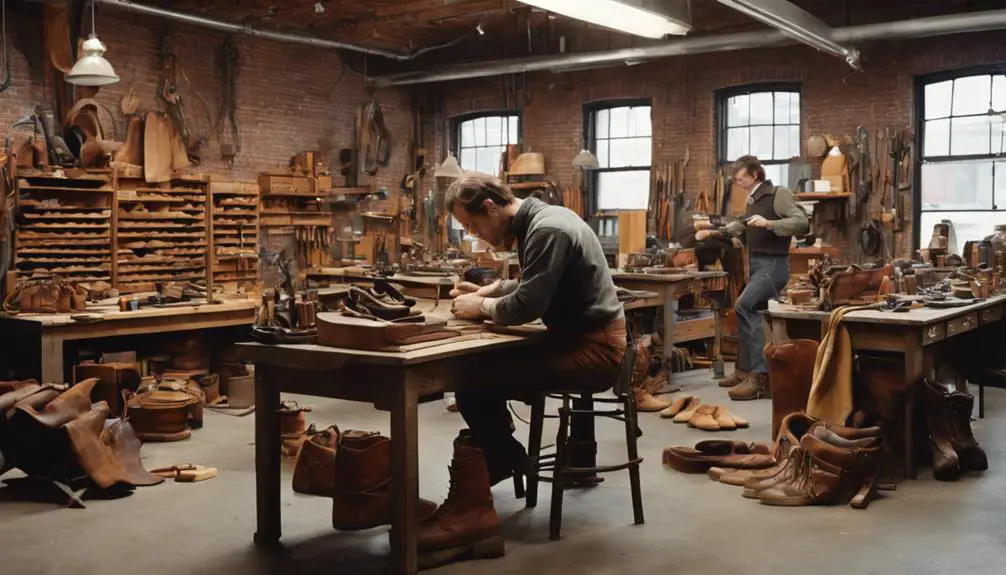Timberland was founded in 1973 in Newmarket, New Hampshire, where Nathan Swartz transformed the footwear industry by introducing a groundbreaking waterproof leather boot. Initially launched as the Abington Shoe Company, the brand catered to hardworking individuals who needed durable footwear. In 1978, the name changed to The Timberland Company, highlighting its focus on quality and outdoor lifestyle. This innovative approach not only met customers' demands but also set the stage for the brand's iconic 6-inch boot. Timberland's commitment to sustainability and style continues today, making it a beloved brand among outdoor enthusiasts and urban fashion fans alike. Explore their journey further for more insights!
Founding Year and Location

Timberland's founding year, 1973, marked the beginning of a footwear revolution in Newmarket, New Hampshire. It was then that Nathan Swartz acquired the Abington Shoe Company, which had been around since 1933. This acquisition laid the groundwork for what would soon become a household name in boots.
In those early days, Timberland focused on innovation, particularly in the domain of waterproof footwear, which played a vital role in establishing their identity in the market. The company aimed to create boots that could withstand the elements while being comfortable and stylish, as evidenced by their history and evolution in the footwear industry. Their first major product, the 6-inch waterproof boot, quickly gained traction among consumers. It wasn't just a boot; it was a statement of durability and functionality. People were drawn to the idea of footwear that could handle rain, mud, and snow without compromising on comfort.
By 1978, Timberland's success prompted them to officially change their name to The Timberland Company, reflecting the growing popularity of their flagship product. This shift symbolized more than just a name change; it was a recognition of their impact on the footwear industry.
The brand continued to grow, and in 1987, it went public, further solidifying its position in the market.
Early Innovations in Footwear
In the early days of Timberland, Nathan Swartz's vision for innovative footwear changed the landscape of boot manufacturing. He introduced revolutionary ideas, particularly the innovative injection-moulding technology that transformed how boots were made. This method allowed him to create waterproof boots that weren't only functional but also comfortable, setting Timberland apart in a crowded market.
The first major product was the 6-Inch Premium Boot, designed specifically for blue-collar workers who needed durable footwear. With high-quality leather that could withstand the elements, these boots quickly became a favorite among laborers who valued both toughness and comfort. The waterproof feature was a game-changer, ensuring that workers could keep their feet dry in even the harshest conditions.
But it wasn't just about performance; Timberland's commitment to quality craftsmanship shone through in every pair of boots produced. From the stitching to the materials used, each element reflected an attention to detail that garnered respect and loyalty from customers. This dedication not only elevated the brand's reputation but also contributed to a significant rise in sales.
By 1988, Timberland's revenues skyrocketed from $48 million in 1983 to an impressive $138 million.
Swartz's innovative spirit and focus on sustainability, including sourcing leather from responsible suppliers, laid the foundation for Timberland's success. His early innovations in footwear not only revolutionized the industry but also created a lasting legacy, demonstrating that quality and innovation can go hand in hand.
The Original Timberland Boot

Launched in 1973, the Original Timberland Boot, also known as the "6-Inch Premium Boot," quickly became a staple for blue-collar workers. Designed with durability in mind, this boot utilized waterproofing technology through injection-molding, setting it apart from other footwear of the time. You could trust it to withstand harsh weather conditions, making it a reliable choice for those who spent their days outdoors.
Much like the innovations in outdoor gear seen in brands like Columbia Sportswear, Timberland focused on creating products that met the demands of an active lifestyle, emphasizing quality and functionality in their offerings groundbreaking technologies.
The iconic original yellow boot gained popularity not just for its functionality but for its style as well. Made from high-quality leather sourced through sustainable practices, it offered both warmth and resilience. These features made the Timberland boot a favorite among workers who needed something tough without sacrificing comfort.
By the late 1970s, Timberland boots accounted for a staggering 80% of the company's sales, showcasing their significant impact on brand growth. As the boot gained traction, the company rebranded itself as Timberland in 1978, solidifying its place in pop culture.
No longer just work boots, they became a symbol of rugged style and practicality. The Original Timberland Boot represents more than just footwear; it's a reflection of quality and craftsmanship that has stood the test of time.
Whether you're hiking through the woods or steering through city streets, the Timberland boot remains a go-to choice for anyone who values durability and style in their everyday life.
Cultural Impact and Brand Growth
There's no denying that Timberland boots transcended their initial purpose as work footwear to become a cultural phenomenon in the 1980s and 1990s. The brand transformed from a rugged boot into a cultural icon, especially within hip-hop and urban fashion scenes. You could see artists like The Notorious B.I.G. and Nas rocking these iconic boots, which solidified Timberland's status in the urban market.
This shift wasn't just about style; it marked a significant turning point in brand growth. Similar to The North Face's evolution from outdoor retailer to cultural icon, Timberland adapted to the changing landscape of consumer preferences.
Timberland's image evolved in response to cultural movements, particularly the Paninari youth movement in Milan and American hip-hop culture. Between 1991 and 2000, the company experienced an impressive surge in profits from $80 million to over $500 million. This growth reflected its successful adaptation to changing cultural trends and identities.
A key moment occurred in 1993 when CEO Jeff Swartz made a controversial remark that sparked increased awareness and engagement with Black consumers. This engagement established a long-term relationship that would benefit the brand immensely.
Today, Timberland stays relevant by collaborating with streetwear and high-fashion designers, creating limited edition designs that appeal to new generations.
Commitment to Sustainability

Timberland's commitment to sustainability shines through its innovative practices that aim to reduce environmental impact. You'll notice that the brand uses recycled materials in its products, showcasing its dedication to eco-friendly manufacturing processes. This commitment goes beyond just materials; it also includes launching their first full circular shoe.
By emphasizing circular economy principles, Timberland encourages you to think about how products can be reused rather than discarded. Their Timberloop program, introduced in 2022, takes this a step further by encouraging recycling and refurbishing of products. This initiative not only minimizes waste but also highlights Timberland's focus on regenerative natural materials.
Furthermore, their expanded take-back program makes it easy for you to recycle old products and reduce your environmental footprint. Timberland's Urban Greening project is another exciting aspect of their sustainability efforts. It focuses on developing green spaces in communities, reflecting a broader commitment to environmental conservation and community engagement.
Additionally, the Path of Service program allows employees paid time for volunteering, promoting initiatives that enhance sustainability and raise environmental awareness. Through these various programs and practices, Timberland demonstrates that their commitment to sustainability isn't just a trend—it's a core part of their identity.




